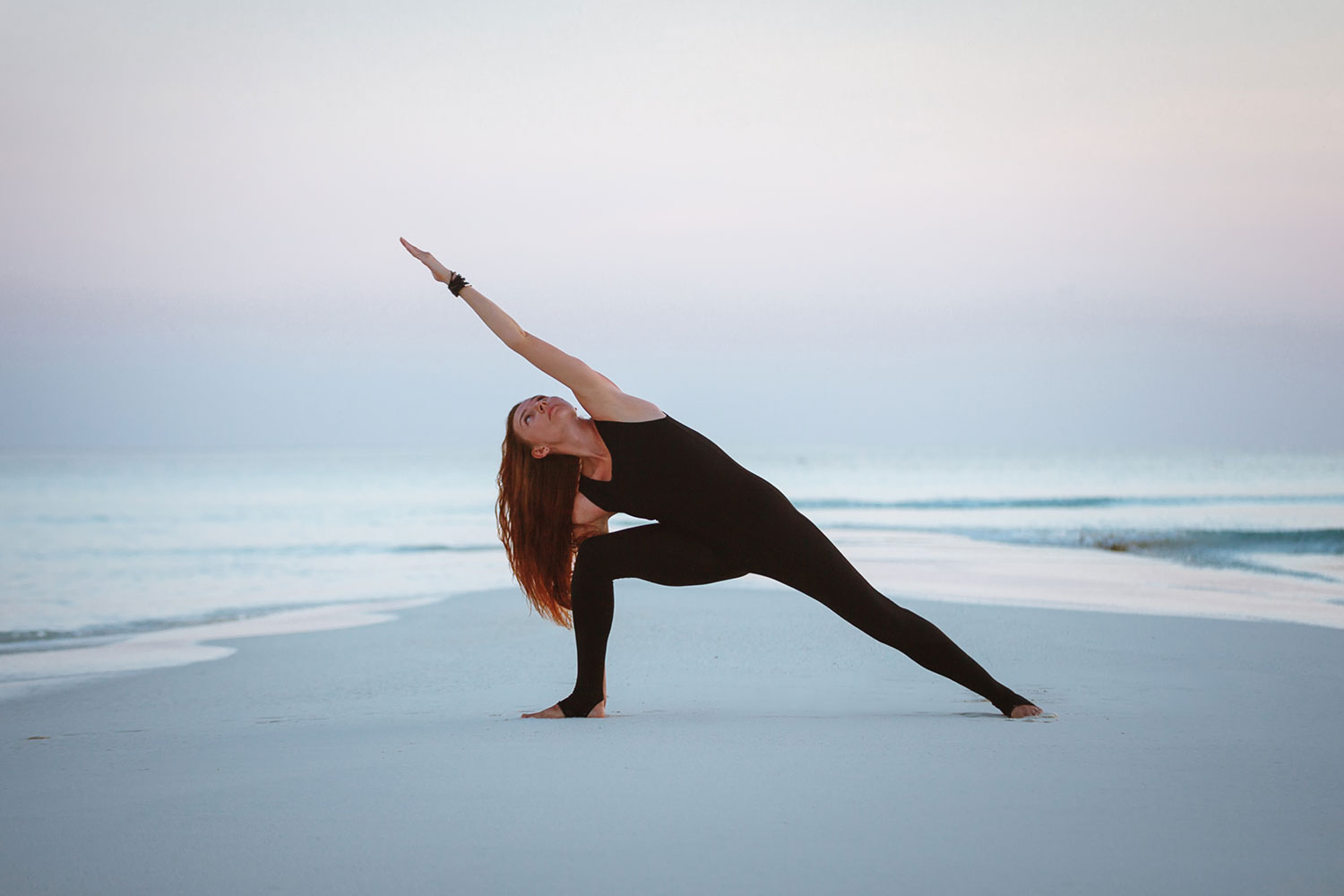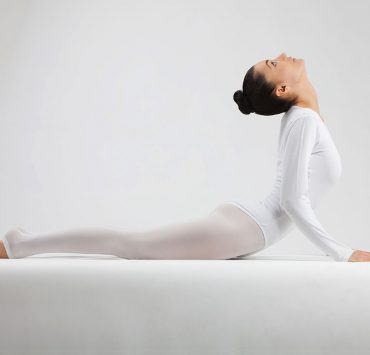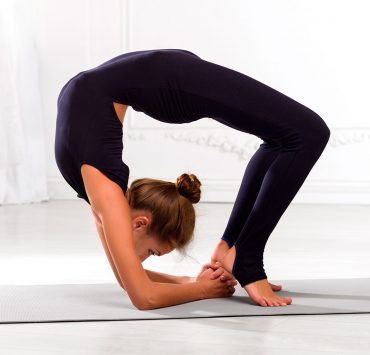
Having been a teacher’s assistant at over 50 yoga teacher…
Asana is the third limb of yoga and it helps prepare the body for meditation. Meditation typically involves sitting for long periods of time and having a strong core can help practitioners meditate more comfortably. In addition to helping prepare the body for meditation, working on the core can help with lower back issues, improve breathing and posture.
Yoga Postures for Core Strength
This article outlines 15 postures to incorporate into your yoga routine to help build core strength. When practicing, always honor the body. The breath should always be at ease. If a pose feels too difficult or challenging, take an easier modification or take the posture out completely until the body is ready to reduce injury or the development of poor form.
Marjaryasana — Cat/Cow Pose

Cat/cow is an excellent preparatory for postures that build core strength. When the two postures are combined they gently stretch and warm up the abdominals while massaging the belly organs. Try practicing cat-cow prior to core strength exercises.
To start, come into a neutral table top posture with the hands underneath the shoulders while the knees and feet are hip distance apart. On an inhale, come into cow pose by releasing the belly and taking the gaze forward. On the exhale round in the upper back while tucking the tailbone under as the chin gets closer towards the chest. Alternate between the two postures for ten full breaths.
For a variation that also provides some much needed stretching for the wrists, do a few rounds with the hands externally rotated until the fingertips face the knees.
Phalakasana — Plank Pose

In addition to stabilizing the spine, toning the whole body, and increasing flexibility in the feet, plank pose or Phalakasana, helps build core strength.
Starting from table step the feet back to the top of a push-up position with the feet hip distance apart. Bring the lower belly in and up, while pressing away from the floor. Keep the gaze downwards between while the hands are pressed firmly into the mat and ensure weight is evenly distributed. The legs should be engaged. Plank can be held anywhere between a few seconds or several minutes as long as the practitioner can still maintain control and ease of the breath.
Be mindful of two specific areas of the body to help maximize plank pose. The first is near the chest, if the chest is sagging try to draw the shoulder blades down the back and try to get the back of the neck and head in line with the spine. If the hips are beginning to drop engage the abdominals and lift them up. If the hips are lifted up, almost a cross between a plank and downward dog, then step the feet father back and lower the hips until they are at a slow diagonal from the spine.
Chaturanga Dandasana — Four Limbed Staff Pose

Four Limbed Staff Pose, more commonly known as Chaturanga Dandasana, can be one of the most challenging transitions in yoga but frequently turns into somewhat of a belly flop from poor alignment. However, when practiced correctly, not only does it work the abdominals and tone the whole body, it is an excellent preparation for arm balances and inversions.
Starting from plank pose, ensure the inside of the elbows are facing each other. Shift the weight forward so the shoulders are slightly in front of the wrists and the heels in front of the toes. Point the elbows towards the back of the mat and bend the elbows trying to keep them close to the rib cage (no chicken wing shapes). While the “goal” may be a 90-degree angle, it is often not possible for people without collapsing in the back and the belly so only bend the elbows towards your own ability.
Less is more with Chaturanga, if the form is bad, there is little that is happening to the core and it becomes possible to injure the body. If it is impossible to keep the belly from flopping on the floor, then lower the knees down creating a slight diagonal from the back of the neck to behind the knees. The glutes should neither be up or sagging.
Vasisthasana — Side Plank Pose

Also known as Vasisthasana, side-plank pose is essentially tadasana or mountain pose on its side supported be one arm. Gravity and balance help the core, arms, and outsides of the legs build strength.
To come into side-plank, start in plank and let the right hand come underneath
the face and slightly in front of the shoulder. Rotate towards the left so the outside of the right foot presses into the mat with the left foot in front of the right to stacked on top. Let the left hand extend towards the sky. Hold for several seconds up to several minutes. After one side, take a few breaths in child’s pose and repeat on the opposite side.
*Note: Students who have any issues with their wrists, shoulders, or elbow issues should avoid side plank or make modifications such as lowering the knee down towards the floor or placing the top foot on the floor in front of the base foot.
Eka Pada Adho Mukha Svanasana — Three-Legged Dog Pose

Three-legged dog or Eka Pada Adho Mukha Svanasana will not only help tone and strengthen the abdominals but can assist in improving posture and reducing anxiety.
Start in downward facing dog and lift the left foot towards to sky but keep the foot gently flexed with the toes pointing towards the ground. Become mindful of the hips, making sure each side stays inline with each other and that the left leg is not rotating out. The left knee should still be facing the floor. Ensure the weight is evenly distributed through the hands. There should be a sensation of pressing away from the wall. Hold for several breaths and repeat on the right side for the same amount of time.
Urdhva Mukha Svanasana — Upward Facing Dog Pose

Upward facing dog or Urdhva Mukha Svanasana can help strengthen the abdominals while simultaneously stretching the back and opening up the chest. However, often when coming directly from a sun salutation the transition can often be too quick to establish time for the body to find proper alignment and get the most from the posture.
We recommend starting in plank to make the transition easier, spend more time in the posture, and establish proper alignment. From plank, flip the feet so the tops press into the mat with the toes released. Lower the hips down towards the floor but without touching while the shins and quadriceps hover a few inches off of the floor. Broaden the chest while lifting the chest as the hands press into the mat with weight evenly distributed throughout the hands. The gaze is forward with the crown of the head lifting.
As upward dog is a backbend its best to take a forward fold or child’s pose afterwards as a counterpose.
Anantasana — Side Reclining Leg Lift Pose

A more gentle approach to building core strength, side reclining leg lift or Anantasana tones the belly, including the sides, while stretching the backs of the legs.
Start by coming all the way down to the mat and lay on the side body fully extending the legs with the head supported by the right hand. Before moving, notice if there is a tendency to roll on the backside. For this posture to work, practitioners need to ensure they are not rolling back onto their glutes by balancing just along the side body. Once a solid base is established, make a peace sign with the left hand, bend the left knee and grab for the inside of the big toe. Readjust the body if it has started rolling backward. Begin to straighten the leg as much as possible without rolling forward or backward. It is more important to stay on the side body trying to balance as opposed to stretching the leg if trying to build abdominal strength and toning.
If the balance is challenged, set the mat up against a wall with the shorter edge of the mat touching the wall, and place the soles of the feet into the wall. Additionally, if someone cannot touch their toes a strap or belt can be used to wrap around the arch of the foot.
Ardha Pincha Mayurasana — Dolphin Pose

Dolphin looks similar to downward facing dog. However, the main difference is the base of the posture than build some serious strength in the body. Not only will it strengthen the abdominals but it will also stretch the shoulders, hamstrings, calves, and arches while building the muscles in the arms and legs.
To start, come into a table top posture and place the forearms on the mat. Curl the toes under, then lift the hips towards the sky. Gradually try to walk the feet closer towards the elbows while pressing into the forearms away from the mat, trying to open the chest towards the shines. Hold for several breaths. Practitioners can alternate between dolphin and dolphin plank.
Makara Adho Mukha Svanasana — Dolphin Plank Pose

Dolphin planks strengthen the core while also assisting in mild anxiety and prevention of osteoporosis.
Start in dolphin pose, softening the knees, and then walk the feet back until the body comes into a plank position with the forearms on the mat. It could be helpful to place a block between the hands and one between the thighs to ensure proper alignment. Practitioners should bring awareness towards the pelvis and glutes ensuring they are neither sagging or lifting up above the lower back. While taking deep breaths, hold the posture for as long as possible until it is no longer possible to control the breath. Release the knees down to come out of the posture or alternate between dolphin and dolphin plank.
Alternatively, this can be an alternative for those attempting regular plank but lack the stability or balance.
Urdhva Dhanurasana — Bow Pose

Bow pose or Dhanurasana not only strengthens the abdominals but gives a full body stretch.
To start, come onto the belly with the arms along the side of the body. To ensure the body stay in proper alignment, place a block between the thighs. Bend the knees and grab for either the outside of the ankles or the tops of the feet. A strap can be placed around the ankles if the hands cannot reach the feet. Gently lift the legs off the mat with the block. Then lift the lower abdominals, upper and then the chest. Additionally, bring the shoulder blades closer together to help open the chest. Hold for several breaths.
After completion of this posture, follow up with forward folds to counterbalance the posture.
Utthita Parsvakonasana — Extended Side Angle Pose

Extended side angle is also known as Utthita Parsvakonasana, will strengthen the obliques if practiced correctly.
Start in Warrior II with the right leg bent. Bring both arms up towards the sky with the palms facing each other. Hinge sideways at the waist towards the right still feeling the upward motion in the torso. While the right elbow can gently be placed on top of the right thigh, before lowering it notice how the body feels particularly in the obliques. When and if the elbow is placed on top of the leg, the same feeling of extension should be felt as opposed to collapsing in either side of the body to get the strengthening and toning of the side body. Hold for several breaths and repeat on the opposite side.
Chakravaka — Sunbird Pose

Sunbird also known as Chakravaka, not only strengthens the core but helps improve balance and posture while working the glutes.
Start in table with the wrists underneath the shoulder and weight evenly distributed throughout the hands.
The knees are hip distance apart with the tops of the feet pressed into the floor. Extend the right arm forward in line with the shoulder and the palm facing left. Extend the left leg back and lift the foot, keeping it gently flexed with the tops of the toes facing the floor. Gaze should be down towards the floor. The weight of the body should be balanced between both the right and left side of the body as well as the top and the bottom. Hold for approximately 5 breaths before coming back into table. Readjust the tabletop posture and complete on the opposite side.
Paripurna Navasana — Boat Pose

Boat pose is a powerful abdominal posture that has many modifications so everyone can practice. While it can be challenging at first, using different modifications can help work up to the full expression of the posture.
Start seated on the mat and plant the soles of the feet onto the floor, letting the legs and feet touch. Set the hands on besides side of the hips. Lengthen the spine while lifting the chest and try to keep upright as the legs lift. Depending on ability, thighs are 45 to 50 degrees relative towards the floor with the legs straight. However, if this is too challenging, start with the knees bent. If possible, lift the arms and extend them forward. Hold for five to ten breaths and repeat three times.
Purvottanasana — Reverse Plank Pose

Reverse plank not only works the abdominals but the back and the legs. Start seated on the floor with the legs in front of the body and the hands slightly back alongside of the hips with the palms pressed into the floor. Press into the hands and gradually lift the hips while pressing either the heels or soles of the feet into the mat. Hold for five to ten breaths.
Virabhadrasana 3 — Warrior 3

Warrior 3 or Virabhadrasana 3 is a powerful balancing pose that can build some serious strength.
Start in a lunge position with the hands on the hip. Take the gaze to a focal point on the floor between four to six feet in front of the body. Shift weight in the left leg and with the gaze on the focal point begin to fold forward at the waist while lifting the back leg. As the leg continues to lift, straighten the leg. Continue to fold forward at the waist until the back and the leg is in line with each other. The right foot should have a gentle flex. Hands can extend forward inline with the shoulders while the palms face each other. Hold for several breaths before releasing back into lunge and repeating on the opposite side.
Another way to help build more strength is to use a wall or chair for support. The hands can either press against the wall or placed on top of the back of a chair. While it will be easier to balance, it will be harder to hold the posture as the body will be able to come closer to the full expression of the posture.
Conclusion
After practicing be sure to finish up with some stretching of the back and the abdominals and drink plenty of water to help the muscles recover.
What's Your Reaction?
Having been a teacher’s assistant at over 50 yoga teacher trainings worldwide, Rebecca Rebecca has a firm grasp on the fine art of yoga and meditation. In her work, she carefully reflects on a vast expanse of knowledge to help others find peace in both body and mind.














